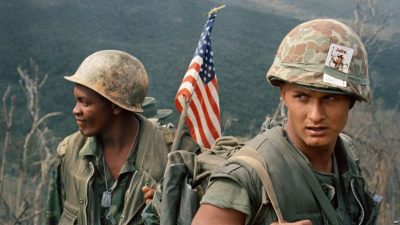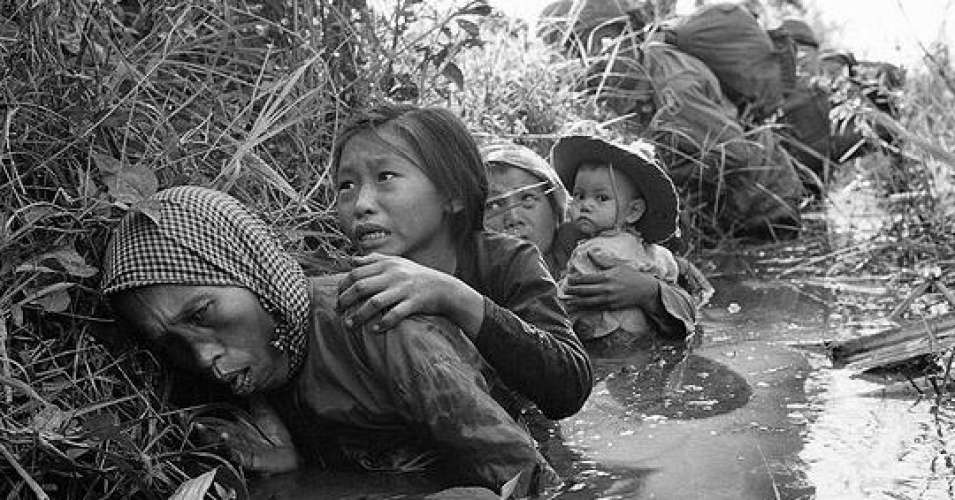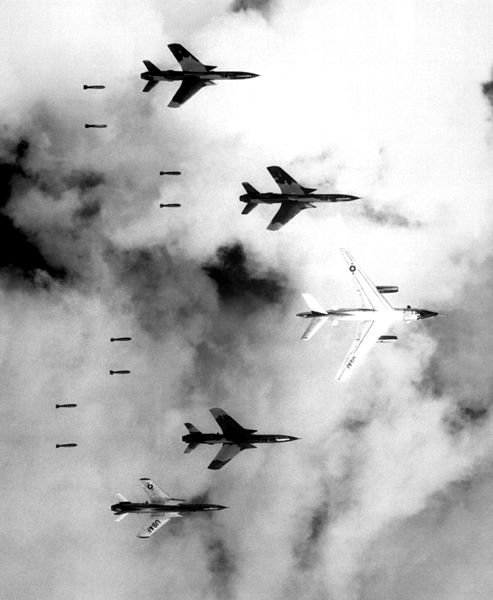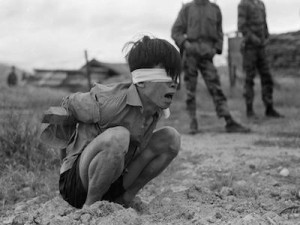President Kennedy’s Role in the Vietnam War

Dwight D. Eisenhower‘s presidency, which ran for eight years from January 1953, is notable in the reluctance of the “great general” to launch large-scale military offensives. This was at a time when American power was immeasurably clear of any other nation on earth.
As president, Eisenhower preferred the coup d’etat to the military invasion. After some cajoling from the British pertaining to Iran, the Americans led a putsch in August 1953 against a nationalist government in Tehran – mainly in order to ensure US-British control over Iran’s massive oil reserves, in “the most strategically important area of the world”, as Eisenhower previously described the Middle East. In June 1954 the Eisenhower administration once more resorted to the coup, this time in Guatemala, with Eisenhower’s fear on this instance being the expansion of independent nationalism in the United States’ “backyard” of Latin America. (1)
Eisenhower refused to send American forces en masse to invade Guatemala, as former president Woodrow Wilson would have done a generation before; but the repercussions for Guatemala and its people were still horrendous, the destruction of her democracy which lingers in the country to this day.
Along south-east Asia, specifically Vietnam, Eisenhower again did not descend to an outright military invasion, though he was clearly concerned about the situation. On 7 April 1954, Eisenhower warned that Japan would turn “toward the Communist areas in order to live” if a communist victory in Indochina “takes away, in its economic aspects, that region that Japan must have as a trading area”. Washington’s trepidation of the “super domino” Japan falling to communist influence spreading forth from Vietnam, would remain a serious concern of American planners over following years. (2)
Yet in reality there was no probability that conservative, US-friendly Japan would have become sympathetic to communism, in the scenario of Vietnam’s “loss”. Nor was there a likelihood, had Vietnam been left in peace, that communism would have spread to the Philippines, India, the Middle East, etc., where the masses in these countries had little idea of what communism entailed.
Though not extending to aggression, Eisenhower instituted and supported state terror methods in the Republic of Vietnam, more commonly known as South Vietnam, a state officially founded in October 1955; pending unification of the country on the basis of free elections, which were meant to be held in 1956. Washington regarded the 1954 Geneva agreements as a “disaster” which stipulated, in effect, to hand Vietnam over to the Vietnamese. Instead, Eisenhower’s government quickly established the Ngo Dinh Diem dictatorship in South Vietnam: So as to eradicate the perceived threat to US hegemony in south-east Asia and beyond.
The American author and historian, Noam Chomsky, wrote that this US-backed terrorist regime had, by 1961, “already taken perhaps 75,000 lives in the southern sector of Vietnam since Washington took over the war directly in 1954. But the 1954-1961 crimes were of a different order: they belong to the category of crimes that Washington conducts routinely, either directly or through its agents, in its various terror states. In the fall and winter of 1961-1962, Kennedy added the war crime of aggression to the already sordid record, also raising the attack to new heights”. (3)
Source: vietnamfulldisclosure.org
Less than nine months into his presidency, on 11 October 1961 John F. Kennedy ordered the dispatchment of a US Air Force squadron “Farmgate” to South Vietnam, consisting of 12 warplanes equipped specifically for counterinsurgency attacks – and which were soon authorised “to fly coordinated missions with Vietnamese personnel in support of Vietnamese ground forces” (4). Under Eisenhower, US soldiers in Vietnam remained in a “strictly advisory” role, not actually participating in raids. This status altered within the first year of Kennedy’s tenure, from terror to aggression.
In June 1956 JFK, then a senator, had outlined that,
“Vietnam represents the cornerstone of the Free World in Southeast Asia, the Keystone to the Arch, the finger in the dike. Burma, Thailand, India, Japan, the Philippines, and obviously Laos and Cambodia, are among those whose security would be threatened if the red tide of communism overflowed into Vietnam”.
His views would change little in coming years.
On 22 November 1961, Kennedy sanctioned the use of US forces “in a sharply increased effort to avoid a further deterioration of the situation” in South Vietnam. It included “increased airlift to the GVN [South Vietnamese regime] in the form of helicopters, light aviation and transport aircraft”. This equipment, along with the arrival of US armed force members to South Vietnam, would partake in “aerial reconnaissance, instruction in and execution of air-ground support and special intelligence” (5). Among the military units were three US Army Helicopter Companies, a Troop Carrier Squadron with 32 planes, fighter aircraft, a Reconnaissance Unit, and six C-123 transport planes equipped for defoliation.
Less than two weeks before, on 11 November 1961 the US National Security Council (NSC) under president Kennedy had ordered the use of “Aircraft, personnel, and chemical defoliants to kill Viet Cong food crops and defoliate selected border and jungle areas”. On 27 November 1961, it was reported that “spraying equipment had been installed on Vietnamese H-34 helicopters, and is ready for use against food crops”. Three weeks later the US Defense Secretary, Robert McNamara, authorised newly-based US warplanes in South Vietnam to begin attacking locals, who were resisting the assaults of the US-imposed dictatorship. By January 1962 further US military hardware had arrived in South Vietnam, such as advanced helicopters, along with providing tactical air support.
Chomsky observed that the above actions by the Kennedy administration “were the first steps in engaging US forces directly in bombing and other combat missions in South Vietnam from 1962, along with sabotage missions in the North. These 1961-1962 actions laid the groundwork for the huge expansion of the war in later years, with its awesome toll”. (6)
JFK put the hawkish McNamara in charge of running the war in Vietnam, despite him having scant experience of front line fighting. McNamara was more acquainted with office work, analysing spreadsheets or graphs. From 1946, he had worked in a civilian position for many years with the Ford Motor Company.
Kennedy was inaugurated as president on 20 January 1961. Over the next year and a half, US soldier numbers in South Vietnam increased sixfold, from about 900 on 31 December 1960, to 5,576 by 30 June 1962. The figures then doubled over the next six months, to 11,300 on 31 December 1962. In the early winter of 1963, at the time of Kennedy’s death, there were around 16,000 US military personnel in South Vietnam (7). During the Kennedy presidency, US troop levels on Vietnamese soil increased almost 20 times over from the end of Eisenhower’s tenure.
In July 1962, Defense Secretary McNamara stressed that US plans relating to Vietnam should stick to “a conservative view”, in that withdrawal of American forces “would take three years, instead of one, that is, by the latter part of 1965”, in the event that victory was obtained by then. This schedule would have taken Kennedy into his second term as president, providing of course that he won re-election. McNamara was Kennedy’s right-hand man, we can note – and the late 1965 timetable, regarding US involvement in Vietnam, dispels the assertions that JFK was planning to imminently withdraw US forces from Vietnam.
General Paul Harkins, himself stationed in South Vietnam, elaborated in his Comprehensive Plan of January 1963 that, “the phase-out of the US special military assistance is envisioned as generally occurring during the period July 1965-June 1966” (8). Moreover, by mid-1962 US “intelligence and sabotage forays” into Ho Chi Minh’s communist North Vietnam had also commenced, according to JFK’s National Security Adviser, McGeorge Bundy. Entering 1963 the US war strategy outlined in January of that year was, as Chomsky noted, “in an atmosphere of great optimism, the military initiatives for withdrawal went hand-in-hand with plans for escalation of the war within South Vietnam, and possibly intensified operations against North Vietnam”.
The reality on the ground bears proof of this. By the summer of 1962 and through 1963, CIA activities in Vietnam were increasing. The CIA partook “in joint clandestine operations” with the South Vietnamese armed forces against North Vietnam; CIA actions in Vietnam were recognised on 11 December 1963 by US National Security Staff member Michael Forrestal. In addition the American journalist William Pfaff had, in mid-1962, personally witnessed a CIA patrol “loading up” in an unmarked US C-46 aircraft northwards of Saigon, and heading to North Vietnam or “possibly into China itself”.
It can be important to examine the views of top level American military commanders, relating to the prospect of waging war in Vietnam. In April 1961, General Douglas MacArthur informed president Kennedy that it would be a “mistake” to fight at all in Asia, and that “our line should be Japan, Formosa and the Philippines”. In July 1961, MacArthur firmly repeated this stance during a three hour long discussion in the White House with JFK, but his advice was ignored (9). MacArthur felt that “the domino theory was ridiculous in a nuclear age”, which purports that one country after another would succumb to communism without US intervention. Kennedy is on record as promoting the domino theory.
MacArthur’s successor as the US Army Chief of Staff, General Matthew Ridgway, expressed similar sentiments to MacArthur. Ridgway had opposed the policies of Eisenhower in Vietnam from 1954, which were undertaken to subvert the Geneva Accords. In 1956, Ridgway wrote that limited US involvement in Vietnam had an “ominous ring”, which he suspected would result in escalation (10). He recalled the US Air Force destruction of North Korea in the early 1950s, and found it “incredible… that we were on the verge of making that same tragic error”, which is what president Kennedy would proceed to do. Ridgway later “passionately opposed intervention in Vietnam”, the military historian Robert Buzzanco acknowledged.
Air Force F-105s bomb a target in the southern panhandle of North Vietnam on June 14, 1966. (Photo credit: U.S. Air Force)
General J. Lawton Collins, another experienced US military man, likewise warned about armed intervention in Vietnam and surrounding regions. Collins said that he did not “know of a single senior commander that was in favour of fighting on the land mass of Asia” (11). General James M. Gavin who, like his above colleagues, had commanded US troops in the front line during World War II, was against invading Vietnam too. Even Kennedy’s closest military adviser, General Maxwell Taylor, expressed misgivings about escalating the conflict.
Meanwhile, in February 1962 JFK’s invasion of Vietnam was undeniable. By that month, US Air Force planes “had already flown hundreds of missions”, according to John Newman, the author and retired US major, who cited an army history. Many of these US airborne operations had a low-ranking Vietnamese enlisted soldier on board, just for show. Also in February 1962, on the 22nd, the top US commander in Vietnam, Lieutenant General Lionel McGarr, informed JFK that “in providing the GVN [South Vietnamese regime] the tools to do the job” Washington “must not offer so much that they [the Vietnamese] forget that the job of saving the country is theirs – only they can do it”. (12)
However, in just one week during May 1962, Vietnamese Air Force and US helicopter units flew about 350 sorties together, including offensives and airlifts. By contrast to the military commanders, the NSC civilian leadership, knowing less about war, favoured increasing the US armed presence in Vietnam. Throughout 1962, the second year of Kennedy’s term, the “main emphasis” for Washington was “on the military effort” in South Vietnam, as deliberated on by Arthur Schlesinger, JFK’s close consultant. US military advisers flocked to South Vietnam bringing with them the machines and instruments of modern war, “from typewriters to helicopters”. Furthermore, US Army personnel in early 1962 were indeed directly participating in military operations in Vietnam, a notable upsurge from the Eisenhower years.
Chomsky wrote that,
“By 1962, Kennedy’s war had far surpassed the French war at its peak in helicopters and aerial fire power… Kennedy’s aggression was no secret. In March 1962, US officials announced publicly that US pilots were engaged in combat missions (bombing and strafing). By October, after three US planes were shot down in two days, a front-page story in the New York Times reported that ‘in 30 percent of all the combat missions flown in Vietnamese Air Force planes, Americans are at the controls’, though ‘national insignia have been erased from many aircraft, both American and Vietnamese,… to avoid the thorny international problems involved’.” (13)
Through 1962, US troops were using HU-1A helicopters against South Vietnamese guerrillas. As an offensive weapon, these helicopters contained more firepower than any World War II fighter aircraft. Contrary to the long established myth that JFK, before his assassination (on 22 November 1963), was on the cusp of withdrawing US forces from Vietnam, the opposite is in fact the case. On 17 July 1963, Kennedy said that if US personnel were sent back home it “would mean a collapse not only of South Vietnam, but Southeast Asia. So we are going to stay there”.
In Kennedy’s dialogue with the broadcast journalist Walter Cronkite on 2 September 1963, the US president said,
“I don’t agree with those who say we should withdraw. That would be a great mistake… this is a very important struggle even though it is far away”. (14)
A week afterwards on 9 September 1963, during an NBC interview Kennedy reiterated, “I think we should stay” in Vietnam because withdrawal “only makes it easy for the Communists” (15). Three days later on 12 September Kennedy expounded,
“What helps to win the war, we support; what interferes with the war effort, we oppose. I have already made it clear that any action by either government which may handicap the winning of the war is inconsistent with our policy or our objectives” (16).
These latter comments by Kennedy, of 12 September 1963, became “a policy guideline” as noted by Roger Hilsman, JFK’s aide and adviser.
On 26 September 1963, less than two months before Kennedy’s death, he said that America stations troops in Vietnam and other nations because “our freedom is tied up with theirs” and the “security of the United States is thereby endangered” if they pass “behind the Iron Curtain. So all those who suggest we withdraw, I could not disagree with them more. If the United States were to falter the whole world, in my opinion, would inevitably begin to move toward the Communist bloc”.
On 1 November 1963, Washington implemented a long-awaited coup to oust the unreliable South Vietnamese dictator Diem. He was killed the following day, along with Ngo Dinh Nhu, his influential younger brother. Nhu had over recent months complained there were “too many US troops in Vietnam”, and the Kennedy administration was worried the brothers were pursuing a secret deal with the North Vietnamese government. JFK was anxious for the coup to proceed and he placed the new US Ambassador to South Vietnam, Henry Cabot Lodge Jr., in operational command of it. Kennedy believed that if the coup failed the US “could lose our entire position in Southeast Asia overnight”. (17)
Kennedy lauded the removal of Diem as being “of the greatest importance”, and he thanked Ambassador Lodge for his “fine job” and “leadership”. With a hawkish new military dictatorship in place in South Vietnam, Kennedy was pleased that “the prospect of defeat” which was “decisive in shaping our relations to the Diem regime” are now in the past. It is again clear that the US president was intent on remaining in Vietnam and escalating the conflict there, only removing US forces after the war was won, or so it was hoped.
Dean Rusk, the US Secretary of State under Kennedy and successor Lyndon B. Johnson, later dismissed allegations that the former intended to withdraw, “I had hundreds of talks with John F. Kennedy about Vietnam, and never once did he say anything of this sort”. (18)
Eight days before the assassination, on 14 November 1963 Kennedy told the media regarding Vietnam there was a “new situation there” following the coup, and “we hope, an increased effort in the war”. JFK continued that the US strategy should be “how we can intensify the struggle” so that “we can bring Americans out of there” (19). In Fort Worth, just a few hours prior to his death, Kennedy produced another statement saying, “Without the United States, South Vietnam would collapse overnight”.
Chomsky affirms that in the time leading up to Kennedy’s shooting,
“there is not a phrase in the voluminous internal record that even hints at withdrawal without victory. JFK urges that everyone ‘focus on winning the war’; withdrawal is conditioned on victory, and motivated by domestic discontent with Kennedy’s war. The stakes are considered enormous. Nothing substantial changes as the mantle passes to LBJ”. (20)
*
Note to readers: please click the share buttons above or below. Forward this article to your email lists. Crosspost on your blog site, internet forums. etc.
Shane Quinn obtained an honors journalism degree. He is interested in writing primarily on foreign affairs, having been inspired by authors like Noam Chomsky. He is a frequent contributor to Global Research.
Notes
1 Susanne Jonas, “50 years later, the lessons from Guatemala”, The Progessive, 21 June 2004
2 Noam Chomsky, Rethinking Camelot (London, Verso Books, 1 April 1993) p. 40
3 Ibid., p. 23
4 Ibid.
5 Ibid., p. 50
6 Ibid., p. 23
7 Jack Valenti, “LBJ’s Unwinnable War”, Washington Post, 28 November 2001
8 Chomsky, Rethinking Camelot, p. 68
9 Francis P. Sempa, “A New Take on General MacArthur’s Warning to JFK to Avoid a Land War in Asia”, The Diplomat, 5 October 2018
10 Parameters: Journal of the US Army War College, Volume 17, p. 64
11 Army University Press, “CSI Report No. 5, Conversations with General J. Lawton Collins”
12 Robert Buzzanco, “Masters of War: Military Dissent and Politics in the Vietnam Era”, (Cambridge University Press; New Ed Edition, 12 Jan. 2008) p. 125
13 Chomsky, Rethinking Camelot, p. 52
14 Mount Holyoke College, “President Kennedy’s Television Interviews on Vietnam, September 2 and 9, 1963”
15 Chomsky, Rethinking Camelot, p. 46
16 American Foreign Policy Current Documents, 1967, p. 873
17 Office of the Historian, “235. Memorandum of a Conference with President Kennedy”, 29 October 1963
18 James T. Patterson, Grand Expectations: The United States, 1945-1974 (OUP USA; New Ed Edition, 12 Feb. 1998) p. 516
19 JFK Library, “News Conference 64, November 14, 1963”
20 Chomsky, Rethinking Camelot, p. 81




